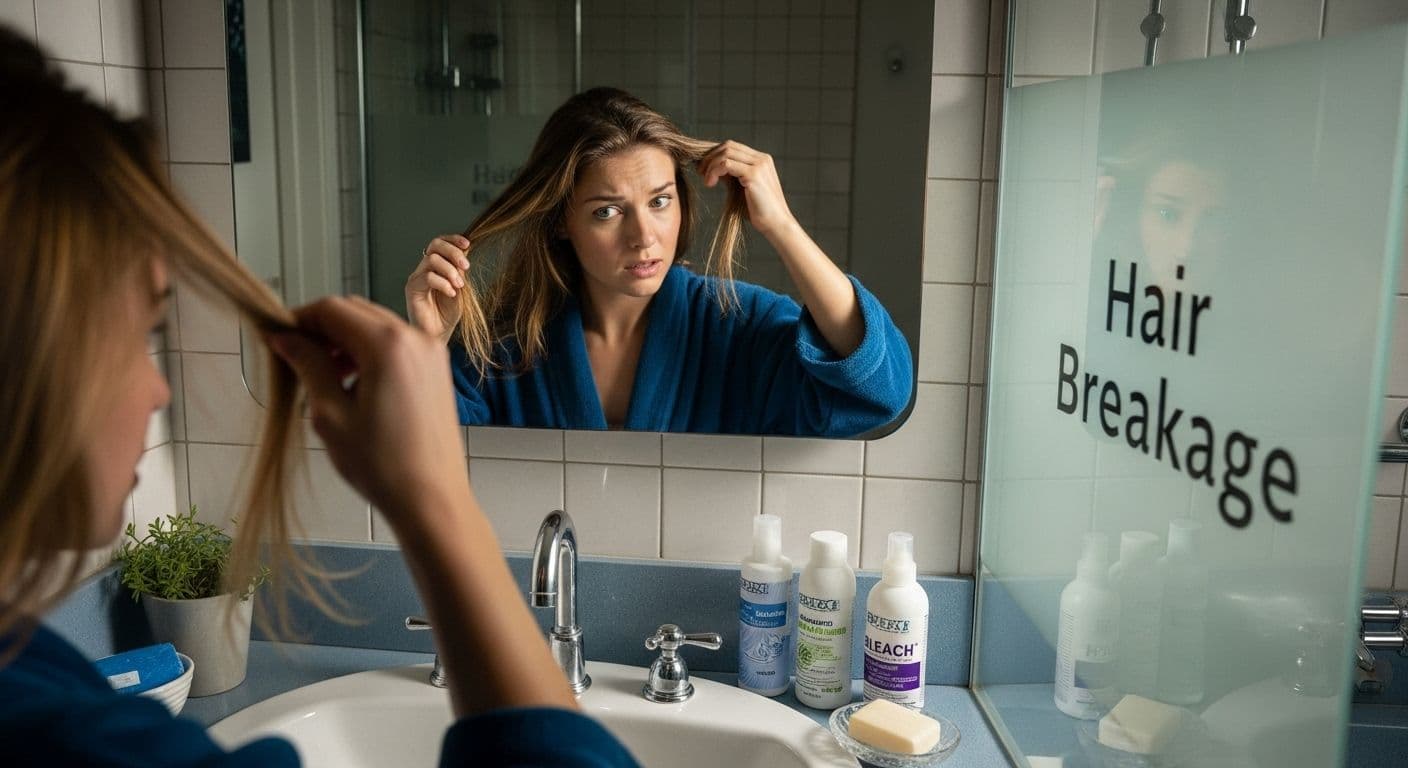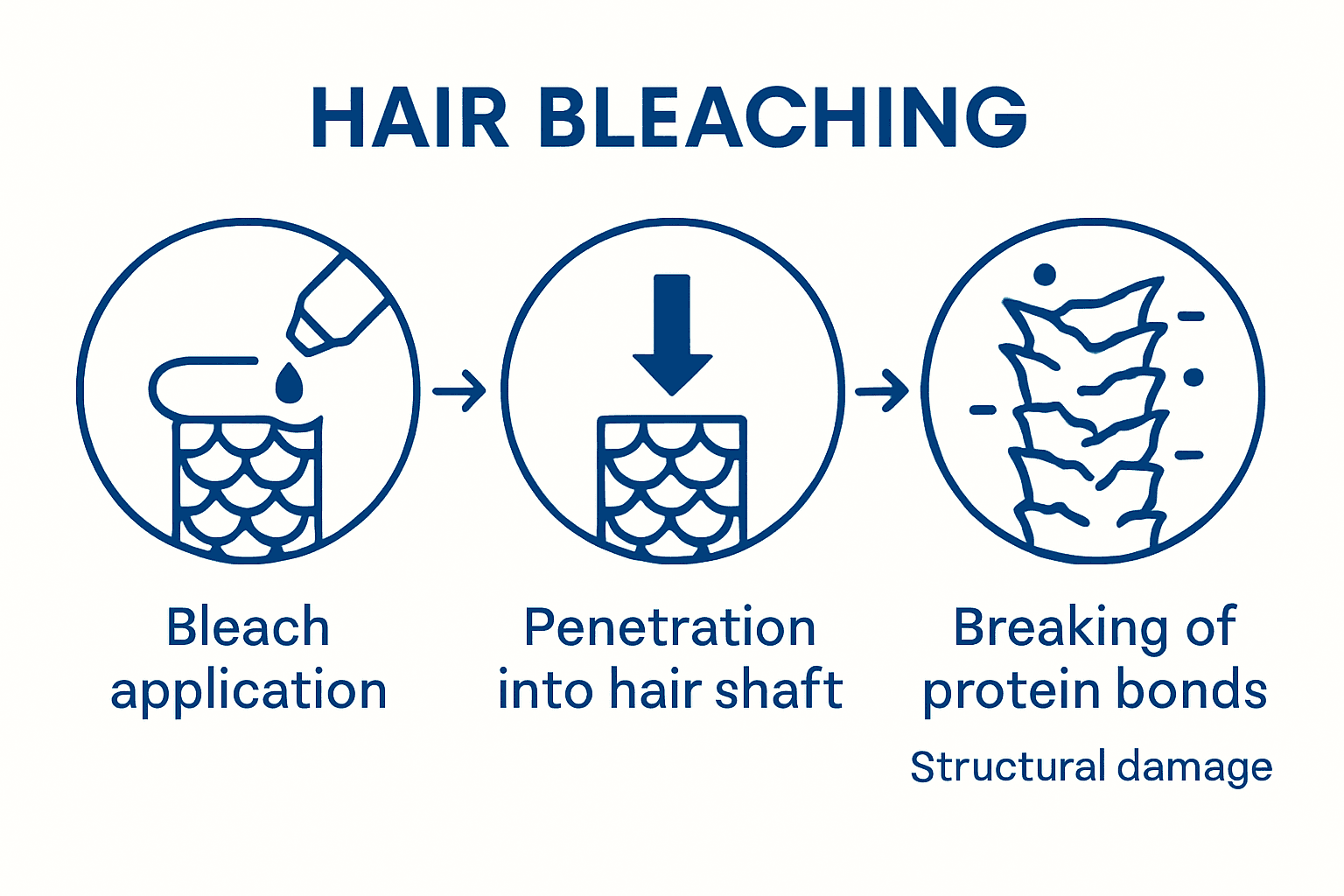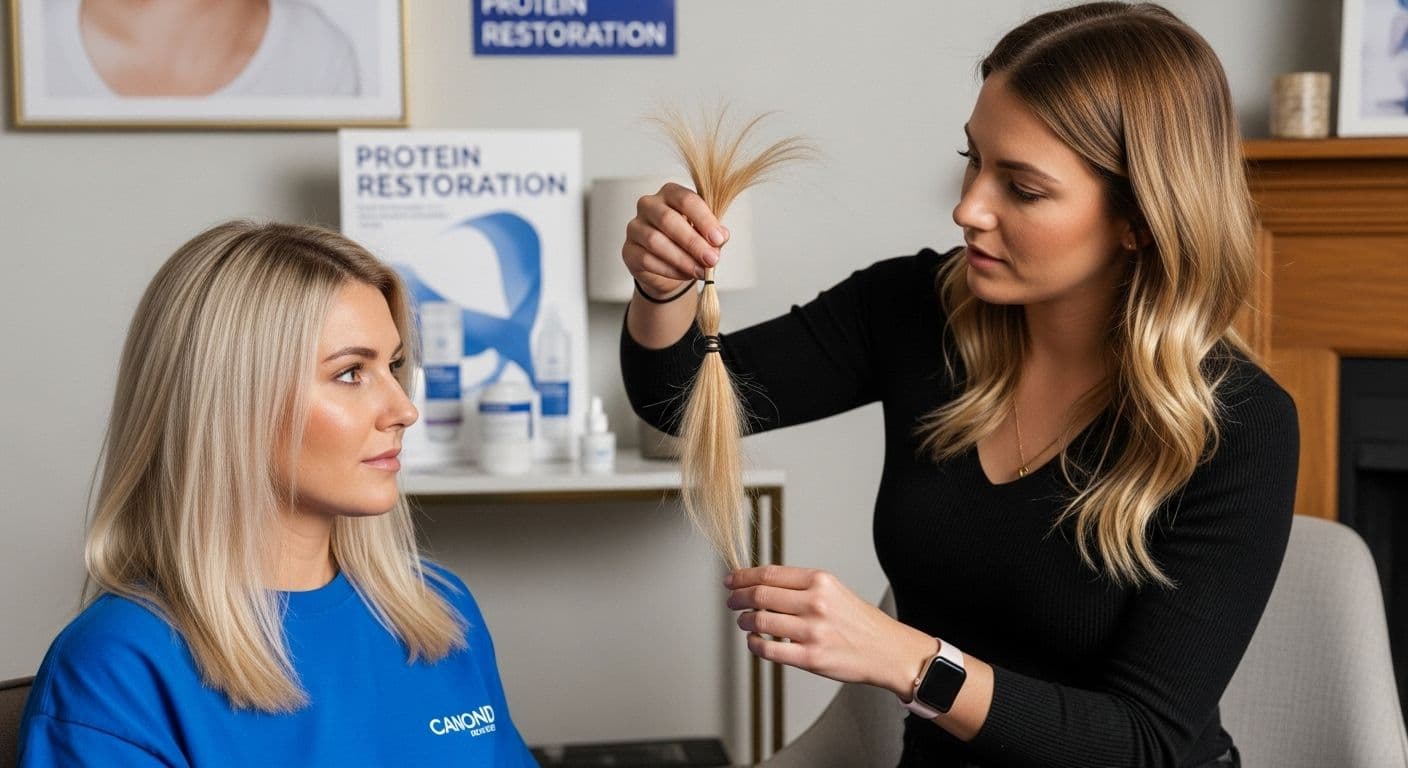Blog
Learning Materials
Understanding Hair Breakage from Bleach: Causes and Effects
Updated: August 20, 2025

Bleach has the power to turn dark hair platinum in just one hour and shockingly, over 60 percent of frequent bleachers report significant hair breakage soon after. Most people expect a fresh color transformation but the real surprise happens behind the scenes as each session quietly breaks down hair’s inner protein backbone. What no one tells you is that hair damage from bleaching is a permanent, microscopic change that even the best conditioners can never truly reverse.
Table of Contents
- What Causes Hair Breakage From Bleach?
- Why Hair Health Matters: The Impact Of Bleach
- How Bleaching Damages Hair Structure
- Key Concepts In Hair Care To Prevent Breakage
- Understanding Recovery: Can Damaged Hair Heal?
Quick Summary
| Takeaway | Explanation |
|---|---|
| Bleach weakens hair structure. | Bleaching agents cause irreversible damage to hair's internal protein structure, making it more susceptible to breakage. |
| Repeated bleaching compounds damage. | Each bleaching session risks further degradation of protein bonds, leading to increasingly fragile hair. |
| Moisture balance is crucial for repair. | Understanding the need for both protein and moisture in hair care helps maintain hair strength and prevent breakage. |
| Complete healing is impossible. | Once hair is damaged by bleaching, it cannot regenerate; proactive care focuses on protective strategies instead. |
| Keratin treatments support recovery. | Utilizing protein-based treatments aids in restoring hair strength and resilience after chemical procedures. |
What Causes Hair Breakage from Bleach?
Hair breakage from bleach is a complex chemical process that fundamentally alters your hair's structural integrity. When bleaching agents interact with hair proteins, they trigger a series of destructive transformations that compromise hair strength and elasticity.
Chemical Mechanism of Hair Damage
Bleaching agents like hydrogen peroxide work by penetrating the hair shaft and oxidizing melanin, the natural pigment responsible for hair color. According to research from the International Journal of Trichology, this process simultaneously breaks down the disulfide bonds within keratin proteins, which are critical for maintaining hair structure.
The key mechanisms of hair damage include:
- Lifting of protective cuticle layers
- Disruption of protein molecular bonds
- Increased hair porosity
- Reduction of natural hair protein integrity
Structural Protein Degradation
When bleach interacts with hair, it creates microscopic structural changes that significantly weaken hair fibers. The oxidative process essentially strips away protective layers, leaving hair vulnerable to breakage. Our guide on preventing hair damage provides deeper insights into protecting your hair during chemical treatments.
Below is a table summarizing the key mechanisms and consequences of hair damage caused by bleaching, as described in the chemical mechanism and structural degradation sections. This helps clarify how bleaching agents impact hair structure on both a molecular and physical level.
| Mechanism/Effect | Description |
|---|---|
| Lifting of Cuticle Layers | Bleach lifts the protective outer cuticle, exposing inner layers |
| Protein Bond Disruption | Breaks disulfide bonds essential for hair strength |
| Increased Porosity | Hair absorbs moisture easily but loses strength |
| Protein Degradation | Structural proteins like keratin are progressively broken down |
| Reduction of Moisture Retention | Hair loses its ability to hold natural moisture |
| Cumulative Structural Weakness | Damage builds up with each bleaching session |
| Greater Environmental Vulnerability | Hair becomes more sensitive to sun, heat, and styling stress |
The most vulnerable hair regions experience progressive protein degradation, where repeated bleaching accelerates molecular breakdown. This means each subsequent bleaching session compounds previous damage, creating increasingly fragile hair strands that are more susceptible to splitting, snapping, and complete structural failure.
Understanding these chemical interactions helps individuals make informed decisions about hair treatments, recognizing that bleaching is not just a cosmetic procedure but a complex chemical intervention with significant potential for long term hair health consequences.
Why Hair Health Matters: The Impact of Bleach
Hair health extends far beyond aesthetic appearance, representing a complex biological system that reflects overall physiological wellness. Bleaching disrupts this delicate ecosystem, creating long term consequences that impact not just hair appearance but potential future hair growth and structural integrity.
Physiological Consequences of Chemical Damage
Chemical bleaching fundamentally transforms hair's natural protective mechanisms. According to research published in the Journal of Cosmetic Dermatology, bleaching creates microscopic structural changes that compromise hair's fundamental protein networks.
The primary physiological impacts include:
- Permanent alteration of hair protein structure
- Reduction of natural moisture retention capabilities
- Increased vulnerability to environmental stressors
- Potential long term follicular damage
Long Term Structural Implications
Repeated bleaching progressively weakens hair's internal protein matrix, creating cumulative damage that extends beyond visible surface changes. Our comprehensive hair restoration guide offers insights into mitigating these complex chemical interactions.
Protein network degradation represents the most significant concern, where each bleaching session incrementally reduces hair's natural resilience. The oxidative process fundamentally breaks down keratin structures, creating increasingly fragile hair strands that become progressively more susceptible to breakage, split ends, and potential permanent follicular stress.
Understanding these intricate biological mechanisms helps individuals recognize bleaching as more than a cosmetic procedure. It represents a significant biochemical intervention with potential long term implications for hair health, requiring careful consideration and professional guidance to minimize potential structural damage.
How Bleaching Damages Hair Structure
Bleaching represents a complex chemical process that fundamentally transforms hair's intricate molecular architecture. When bleaching agents interact with hair fibers, they initiate a series of destructive chemical reactions that compromise the entire structural integrity of hair from its core.
Molecular Breakdown of Hair Proteins
According to research from the International Journal of Trichology, bleaching agents like hydrogen peroxide penetrate deep into hair fibers, targeting and disrupting critical protein structures. This process specifically targets and breaks down disulfide bonds, which are essential for maintaining hair's strength and elasticity.

The key structural modifications include:
- Permanent alteration of keratin protein configuration
- Destruction of protective cuticle layers
- Increased microscopic porosity within hair shaft
- Reduction of natural protein cross linking
Cuticle and Cortex Transformation
Bleaching creates profound changes in both the hair's external cuticle and internal cortex. Explore our detailed hair restoration strategies to understand comprehensive hair protection techniques.
Oxidative stress fundamentally restructures hair's molecular composition, creating microscopic fissures and weakening the protein matrix. Each bleaching session progressively erodes the hair's natural protective mechanisms, transforming robust hair fibers into increasingly fragile and vulnerable structures.
Understanding these intricate molecular interactions reveals bleaching as far more than a cosmetic procedure. It represents a significant biochemical intervention that can permanently alter hair's fundamental structural characteristics, requiring careful consideration and professional expertise to minimize potential long term damage.
Key Concepts in Hair Care to Prevent Breakage
Preventing hair breakage requires a comprehensive understanding of hair structure, chemical interactions, and proactive maintenance strategies. Successful hair care goes beyond surface treatments, demanding a holistic approach that addresses both internal nutritional factors and external protective mechanisms.
Protein Restoration and Protection
According to research from recent hair care studies, protein-based interventions play a critical role in mitigating hair damage. These strategies focus on rebuilding and reinforcing the hair's molecular structure, particularly after chemical treatments like bleaching.
Key protein restoration techniques include:

- Targeted keratin protein treatments
- Deep conditioning with protein enriched products
- Minimizing heat and chemical exposure
- Regular protein reconstruction therapies
Moisture and Structural Balance
Hydration equilibrium represents a fundamental concept in preventing hair breakage. Check out our comprehensive hair protection strategies to understand advanced moisture management techniques.
The delicate balance between protein and moisture determines hair's resilience. Excessive protein can make hair brittle, while insufficient protein leads to weakness. Successful hair care requires understanding this intricate balance, implementing targeted treatments that restore structural integrity without overwhelming the hair's natural protein network.
Understanding these sophisticated hair care principles transforms hair maintenance from a cosmetic routine into a scientific approach. By recognizing hair as a complex biological system, individuals can develop personalized strategies that protect, restore, and maintain hair health through informed, proactive interventions.
Understanding Recovery: Can Damaged Hair Heal?
The concept of hair recovery requires nuanced understanding, recognizing that hair is a non living protein structure with limited regenerative capabilities. While complete healing is impossible, strategic interventions can significantly improve hair's appearance, strength, and manageability after chemical damage.
Biological Limitations of Hair Repair
According to research from the Journal of Clinical and Aesthetic Dermatology, hair cannot regenerate or heal itself in the traditional biological sense. Once damaged, the structural modifications caused by bleaching and chemical treatments are permanent at the molecular level.
Key biological constraints include:
- Inability to repair permanently broken protein bonds
- Lack of cellular regeneration mechanisms
- Permanent cuticle layer disruption
- Irreversible molecular structural changes
Restoration and Management Strategies
Protein reconstruction offers the most promising approach to managing chemically damaged hair. Explore our comprehensive hair restoration techniques to understand advanced recovery methods.
While complete healing remains impossible, targeted treatments can temporarily improve hair's structural integrity. Protein based conditioners, deep treatment masks, and specialized hair care products can coat damaged fibers, creating a protective layer that minimizes further breakage and improves overall hair appearance.
Here is a table that compares the biological limitations of hair repair with possible management strategies, helping readers understand what is and is not achievable after bleach damage.
| Aspect | Biological Limitation | Management Strategy |
|---|---|---|
| Protein Bond Repair | Broken protein bonds cannot be healed | Apply protein-rich treatments to reinforce and coat damaged hair |
| Regeneration Capability | No self-healing or regrowth of damaged fiber | Use restorative masks/conditioners for temporary improvement |
| Cuticle Restoration | Disrupted cuticle layers are permanently lost | Moisturize and protect with oils or leave-ins |
| Structural Integrity | Permanent molecular changes cannot be undone | Minimize further chemical and heat exposure |
| Follicle Impact | Potential for long-term follicular stress | Focus on scalp health and gentle hair care |
Understanding hair's biological limitations transforms recovery expectations from magical healing to strategic management. By adopting a realistic approach focused on protection, hydration, and controlled protein intervention, individuals can effectively mitigate the long term consequences of chemical damage and maintain healthier hair structures.
See What Bleach Is Doing to Your Hair—Get a Personalized Analysis Now
Are you worried that bleaching has caused your hair to lose strength or become more fragile? After reading about how chemical treatments break down your hair’s protein structure and strip away natural protection, you might be wondering if it is too late to reverse the damage. It is normal to feel anxious about breakage, protein loss, or split ends, especially when you are not sure exactly what is happening beneath the surface. The effects of chemical bleaching are real, but with expert guidance, you can take control of your hair health.

Why guess about the state of your hair or risk further damage? Head to MyHair.ai and upload your scan for a free AI-powered assessment. You will receive detailed and science-backed insights into your hair’s structure and a personal action plan to reduce breakage and support healthier growth. Want targeted solutions for recovering from protein loss, hydration problems, or breakage? Explore the step-by-step guidance in our hair restoration strategies and learn how to stop breakage with proven tips and techniques. Your journey to stronger, more resilient hair starts now—take your first step with MyHair.ai today.
Frequently Asked Questions
What causes hair breakage after bleaching?
Hair breakage after bleaching is primarily caused by the chemical interactions between bleaching agents and hair proteins. Bleaching agents like hydrogen peroxide penetrate the hair shaft, disrupting protein molecular bonds and increasing hair porosity, leading to weakened and brittle strands.
How can I prevent hair breakage from bleach?
To prevent hair breakage from bleach, consider using targeted protein treatments, minimizing heat exposure, and incorporating deep conditioning with protein-enriched products. Maintaining a balanced moisture level is also crucial for hair's resilience.
Can damaged hair recover after bleaching?
While hair cannot fully recover due to its non-living nature, strategic interventions like protein reconstruction and moisturizing treatments can significantly improve the appearance and manageability of chemically damaged hair.
What are the long-term effects of bleaching on hair health?
Long-term effects of bleaching on hair health include permanent alteration of hair protein structure, increased vulnerability to environmental stressors, and potential follicular damage. These changes can lead to ongoing issues like breakage and split ends.